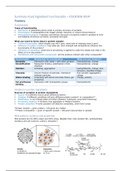Summary Food Ingredient Functionality – FCH30306 WUR
Proteins
Functionality
Types of functionality
• Nutritional → (essential) amino acids in primary structure of proteins
• Physiological → polypeptides that trigger allergic reactions or reduce blood pressure
• Physical/technological → primary and tertiary structure of proteins makes it possible to form
and stabilise structures as foams, emulsions and gels.
What you want to know about a protein sample:
• Techno-functionality: which droplet size will it give, what kind of rheology does it give?
• Influence of system conditions: how does pH, ionic strength and temperature influence the
functionality of this protein?
• Influence of processing: what kind of processing is applied to make the isolate and what is the
effect of it on the protein?
• Interactions with non-protein compounds: will the proteins interact with other compounds?
Functionality Mechanism for functionality What can you measure?
Solubility Interaction with water / with other proteins Hydrophobicity, charge
Emulsification Adsorption kinetics, stabilisation of the Hydrophobicity, charge
interface
Gelation Unfolding, aggregation Hydrophobicity, charge, size,
structure, disulfide bridges
Viscosity Volume fraction of particles, interaction Size (protein aggregates),
between particles charge
Water binding H-bonding with amino acid side chains, gel Charge, polarity
properties
Fat and flavour Interaction with hydrophobic groups Hydrophobicity
binding
Variation in protein ingredients
Sources of variation in protein ingredients
• Source → a different source gives different proteins
• Isolation → different conditions will give different protein content* or composition**
• Modification → can change state of protein (Mailard, hydrolysis, enzymatic browning)
• Processing (heating) → proteins may aggregate or Mailard reaction.
• Powder properties → some powders will dissolve completely, other form lumps
*Protein content = gram protein / 100 gram dry matter
**Protein composition = gram of specific protein / 100 gram total protein in sample
Milk proteins: isolation and properties
Milk proteins are for 80% casein and 20% whey. Besides that, milk contains fat, carbohydrates
(lactose) and ash (calcium, sodium, phosphor)
, Casein
• Caseins are much larger than whey and lactose! Easy to use filtration for milk.
• Caseins are precipitated by adding rennet or acid so they aggregate.
• Casein protein molecules are phosphorylated because acidic phosphate groups are added. This
results in a decrease of the IEP. Besides that, the phosphate groups can have a strong
interaction with divalent ions such as calcium.
• Caseins are random coil proteins! Do not have a secondary or tertiary structure!
• Because of unequal distribution of the hydrophobicity and charge, caseins associate in micelles.
These micelles cluster together in macro-micelles because of calcium-phosphate bridges.
Phosphate from the serine amino acids.
• On the outside of the macro micelles are kappa-caseins, which contain a larger carbohydrate
group.
• At the pH of milk (6.7), casein micelles are considered to be soluble. However, when
carbohydrate groups on kappa-casein are removed by rennet, or when the pH is lowered, the
micelles will aggregate.
o Rennet casein: precipitation by rennet (removal of kappa casein, aggregation)
o Acid casein: pH lowered to 4.6 (aggregation because less charge)
o Na/K-caseinate: acid casein of which the pH is re-adjusted.
o Micellar casein: milk is filtrated.
• Casein proteins are very hard to dissolve.
Whey
• Obtained after separation of lipids and caseins from milk. Sometimes lactose is also removed.
• By chromatography you can yield whey proteins enriched in a-lactalbumin or B-lactoglobulin.
• WPC 35 contains 65% other components. For instance lactose. This can give a lot of Mailard
reaction.
• It is always important to know what the other components are!
Protein concentrate = 35-80% protein
Isolate = > 90% protein
Other food proteins
Gelatin
• Formed from collagen after extraction from animal skin or bone tissue by boiling.
• Mainly consists of tropocollagen → triple helix (so made of three polypeptide chains)
• Consist mainly of three amino acids: glycine-x-x. One of the other two is mostly
(hydroxy)proline.
• Proline contains an angle that prevents the formation of normal alpha helices or B-sheet.
Alpha helix Triple helix Beta-sheet
• High temperatures induce loss of native triple helical structure. After cooling the rearrange →
reversible gel structure
Storage proteins from leguminosa and oil seeds
• Soy, pea and rapeseed protein
• Globular proteins (so more similar to whey than casein)
• Important: different non-protein compounds can come along during extraction and thereby
influence the composition and final properties of the isolate
Protein modifications
Heating
• Structure of proteins can be disrupted by heating. How, depends on the structure.




